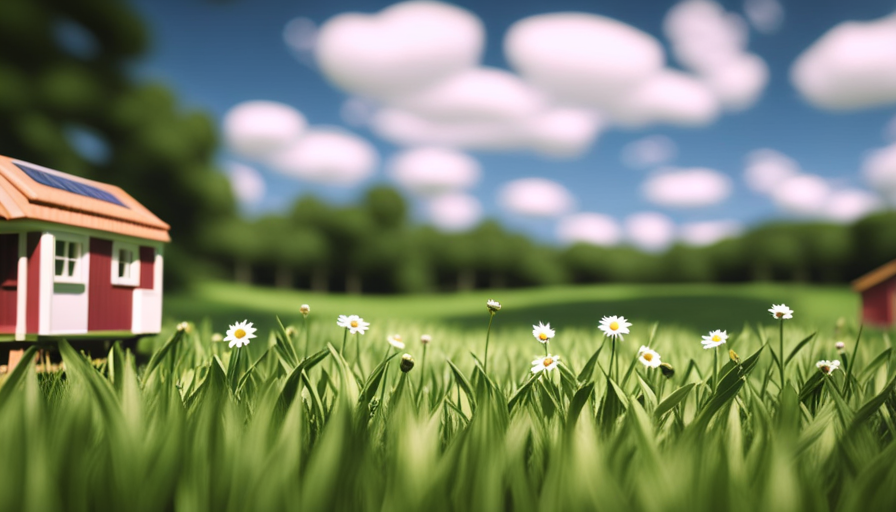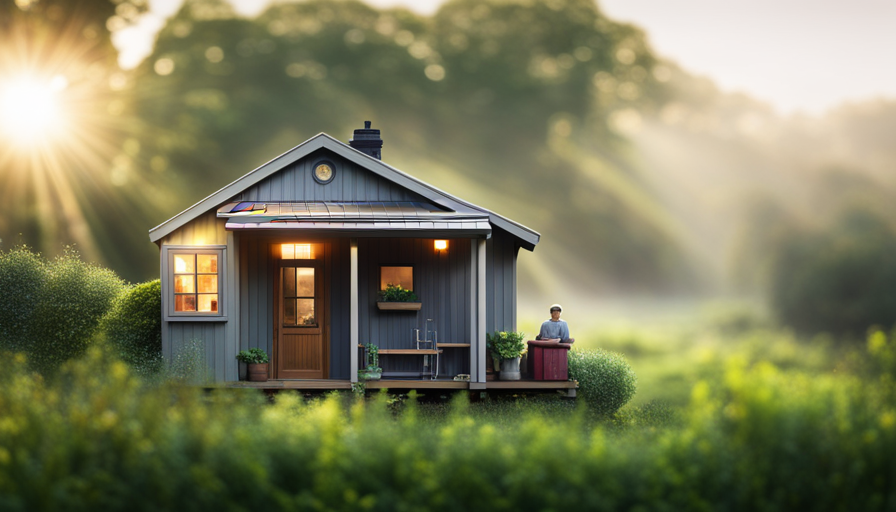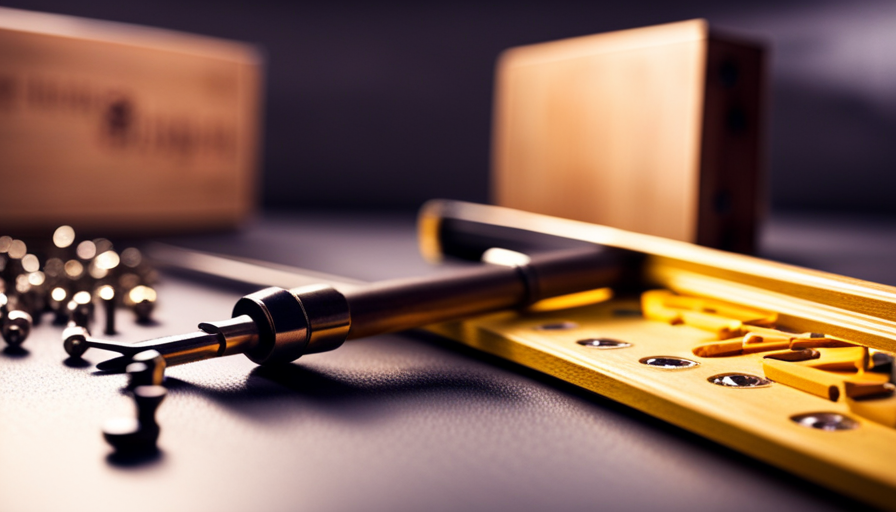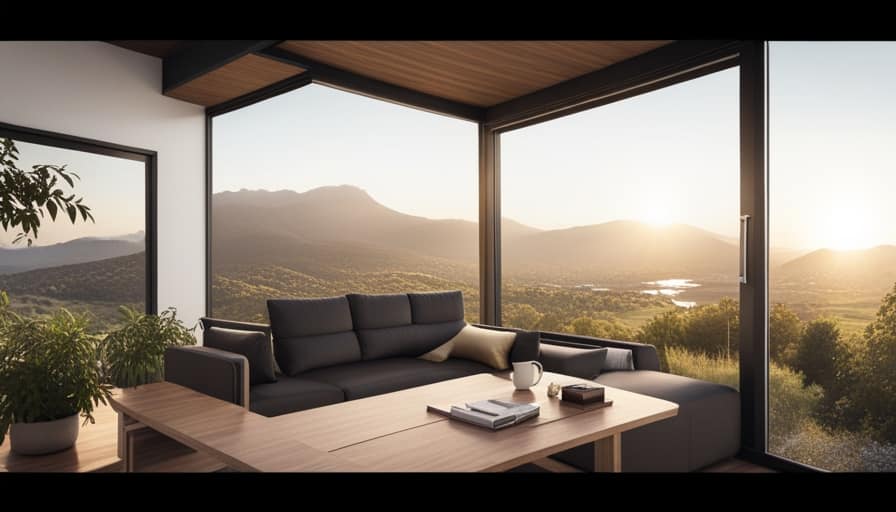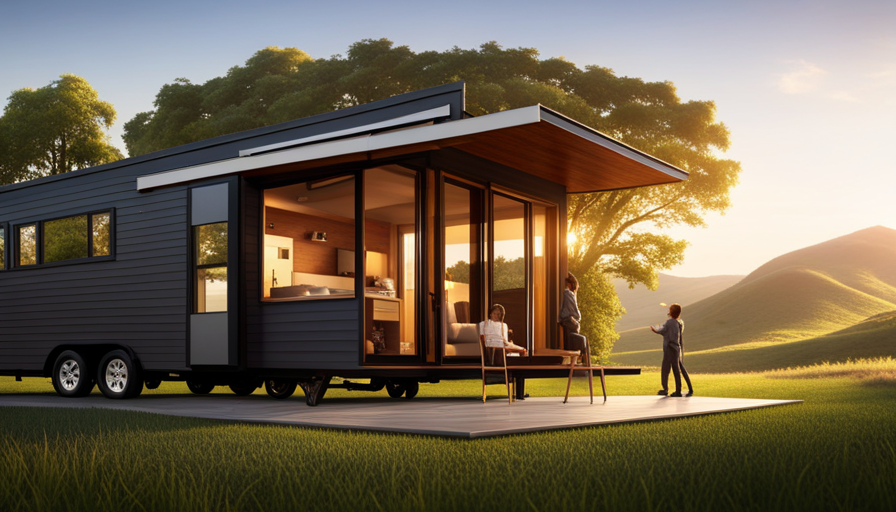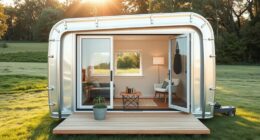Curious about how much energy a small house uses? Get ready to be surprised! These compact homes use significantly fewer kilowatt-hours (kWh) compared to larger homes.
In fact, the energy consumption of a tiny house can be so low that it’s almost laughable.
In this article, I will delve into the fascinating world of energy consumption in tiny houses. We’ll explore the factors that affect power needs, calculate average usage, and discuss choosing energy-efficient appliances and systems.
But that’s not all – I’ll also share some handy tips for reducing energy consumption in these compact abodes.
Whether you’re considering downsizing to a tiny house or simply curious about their sustainability benefits, this article has got you covered. So buckle up and prepare to be amazed by just how little electricity a tiny house really requires!
Key Takeaways
- Tiny houses require fewer kWh than larger houses.
- Factors affecting power needs in tiny houses include insulation, energy-efficient appliances, and passive solar design.
- Renewable energy sources like solar panels and wind turbines can provide sustainable power for tiny houses.
- Evaluating power needs for tiny house living involves considering energy-efficient appliances, lifestyle and usage patterns, and climate and location.
Understanding Energy Consumption in Tiny Houses
You’ll be amazed at how little energy your tiny house consumes! Understanding energy efficient design and optimizing power usage are key factors in minimizing energy consumption in a tiny house.
With limited space, it’s important to make the most of every square inch when it comes to energy efficiency. One way to achieve this is by using insulation materials that provide a high level of thermal resistance. This helps keep the interior temperature stable, reducing the need for heating or cooling systems.
Additionally, installing energy-efficient appliances such as LED lights and low-flow water fixtures can significantly decrease power usage. Another aspect to consider is passive solar design. By strategically placing windows and using natural shading techniques, you can harness the sun’s energy for heating and lighting purposes, further reducing your reliance on traditional power sources.
When evaluating power needs for tiny house living, it’s essential to assess your daily activities and prioritize your electricity usage accordingly. Investing in renewable energy sources like solar panels or wind turbines can provide an independent and sustainable power supply for your tiny house.
By understanding energy efficient design principles and optimizing power usage, you can greatly reduce your overall energy consumption in a tiny house. Now let’s move on to evaluating power needs for tiny house living without compromising comfort or convenience.
Evaluating Power Needs for Tiny House Living
Calculating the power requirements for a cozy abode on a smaller scale is like unraveling a delightful puzzle. It’s essential to evaluate power needs accurately to ensure that your tiny house has enough electricity to run smoothly.
To help you navigate this process, here are three key factors to consider:
-
Energy Efficient Appliances: Opting for energy-efficient appliances can significantly reduce your power needs. Look for appliances with an ENERGY STAR rating or those specifically designed for off-grid living.
-
Lifestyle and Usage Patterns: Consider your daily routines and habits when evaluating power needs. Do you work from home? Do you enjoy cooking elaborate meals? Understanding how you use electricity will help determine the appropriate capacity.
-
Climate and Location: Different climates require varying amounts of energy for heating or cooling purposes. Take into account the local weather conditions and insulation levels of your tiny house.
By evaluating these aspects, you can assess how many kilowatt-hours (kWh) are necessary for your tiny house lifestyle.
The next step in understanding energy consumption in tiny homes is calculating average energy usage based on these requirements without unnecessary waste or overspending on resources.
Calculating Average Energy Usage in Tiny Homes
When it comes to determining how much energy your cozy abode needs, it’s important to consider your lifestyle and daily habits. Calculating energy efficiency and optimizing power usage are key factors in ensuring you have the right amount of electricity for your tiny house. To help you understand average energy usage in tiny homes, let’s take a look at the following table:
| Appliance | Power Consumption (kWh) |
|---|---|
| Refrigerator | 1-2 kWh/day |
| Lights | 0.5-1 kWh/day |
| Heating/Cooling | 2-3 kWh/day |
| Electronics | Varies |
By analyzing these numbers, you can estimate an average daily energy consumption for your tiny house. However, keep in mind that individual lifestyles may vary and additional appliances or gadgets will increase usage.
Understanding how much energy is necessary for a tiny home is crucial in order to optimize power usage and avoid wastage. Factors affecting energy consumption in compact dwellings will be discussed further in the next section, where we’ll delve into things like insulation, solar panels, and efficient appliances.
Factors Affecting Energy Consumption in Compact Dwellings
Optimizing power usage in compact dwellings is crucial for reducing energy consumption and maximizing efficiency. When evaluating energy-efficient options, it’s important to consider the factors that can affect energy consumption in tiny homes.
One key factor is insulation. Proper insulation helps maintain a comfortable temperature inside the house, reducing the need for heating or cooling systems and therefore lowering energy usage.
Another factor to consider is lighting. Choosing LED bulbs instead of traditional incandescent ones can significantly reduce electricity consumption without compromising on brightness.
Additionally, appliance selection plays a vital role in optimizing energy usage. Energy Star certified appliances are designed to be more efficient, using less electricity while still providing the same level of performance.
It’s also worth noting that utilizing natural light through strategically placed windows and skylights can minimize the need for artificial lighting during daylight hours.
By evaluating these energy-efficient options and optimizing our energy usage, we can make significant strides towards reducing our environmental impact and saving on utility costs.
When it comes to choosing energy-efficient appliances and systems, there are several factors to consider… [transition into subsequent section]
Choosing Energy-Efficient Appliances and Systems
Selecting energy-efficient appliances and systems is a smart move to reduce energy consumption and save on utility bills. When it comes to tiny houses, where space is limited, choosing the right appliances becomes even more crucial. By opting for energy-saving options, you can ensure that your tiny house remains comfortable while minimizing its overall energy usage.
One effective way to select efficient appliances is by comparing their Energy Star ratings. These ratings indicate how much energy an appliance uses compared to similar models. Additionally, consider the size of the appliance and its capacity in relation to your needs. For example, a smaller refrigerator will consume less electricity than a larger one.
To further maximize efficiency, it’s important to invest in systems that work well together. For instance, pairing a high-efficiency HVAC system with proper insulation will help regulate temperature effectively while using minimal energy.
Here’s a table showcasing some key considerations when selecting energy-efficient appliances for your tiny house:
| Appliance | Energy Saving Tip |
|---|---|
| Refrigerator | Opt for an Energy Star certified model with appropriate size for your needs |
| HVAC System | Choose a high-efficiency unit that matches the square footage of your tiny house |
| Lighting | Use LED bulbs instead of traditional incandescent ones |
By implementing these energy-saving tips and selecting efficient appliances and systems, you can significantly reduce your tiny house’s overall energy consumption. In the next section, we’ll explore alternative energy sources for tiny houses without compromising on comfort or convenience.
Exploring Alternative Energy Sources for Tiny Houses
One way to power your compact home efficiently and sustainably is by exploring alternative energy sources. When it comes to small spaces, there are several renewable energy options available that can meet the energy needs of a tiny house.
Solar power is one popular choice for tiny homes, as it’s a clean and abundant source of energy. Installing solar panels on the roof of your tiny house can generate electricity from sunlight, which can be stored in batteries for later use.
Another alternative energy source for small spaces is wind power. While not as common as solar power for tiny houses, wind turbines can be used to harness the power of the wind and convert it into electricity. However, it’s important to note that wind turbines require a certain amount of space and may not be suitable for all locations.
In addition to solar and wind power, some tiny homeowners also explore hydroelectricity as an alternative energy source. If you have access to a nearby stream or river with a significant flow, installing a micro-hydro system can provide you with a reliable source of renewable energy.
Exploring alternative energy sources for your tiny house allows you to reduce your reliance on traditional grid-based electricity while living sustainably. By incorporating these renewable options into your compact living space, you can enjoy the benefits of clean and efficient energy generation without compromising on comfort or convenience.
Transition: Now that we’ve explored alternative energy sources for powering your tiny house efficiently, let’s move on to some tips for reducing overall energy consumption in small homes.
Tips for Reducing Energy Consumption in Tiny Homes
Now that we’ve explored alternative energy sources for tiny houses, let’s delve into some practical tips for reducing energy consumption in these small spaces. Energy saving is crucial when it comes to tiny homes, as every kilowatt-hour (kWh) counts.
Here are some effective strategies to help you minimize your energy usage and live more sustainably.
Firstly, optimize insulation by using high-quality materials and sealing any gaps or cracks. This will reduce the need for heating or cooling appliances, consequently lowering your energy consumption.
Secondly, invest in energy-efficient appliances such as LED lights, low-flow showerheads, and programmable thermostats. These upgrades can significantly decrease your overall power usage.
Additionally, utilize natural light as much as possible by incorporating large windows or skylights into your design. This will not only brighten up your space but also reduce reliance on artificial lighting during the day.
Furthermore, make sure to unplug electronics when they’re not in use and consider using power strips with switches to easily turn off multiple devices at once.
By implementing these energy-saving tips for tiny homes, you can greatly reduce your environmental impact while also cutting down on utility costs.
Transitioning into the subsequent section about managing energy usage in off-grid tiny house living, it’s important to understand how to effectively harness renewable energy sources for sustained power supply without relying on traditional grid systems.
Managing Energy Usage in Off-Grid Tiny House Living
To effectively manage your energy usage in an off-grid tiny home, envision a sustainable lifestyle that relies on renewable energy sources and minimizes reliance on traditional power grids.
Here are three key strategies for managing energy usage in your off-grid tiny house:
-
Install Energy Efficient Appliances: Choose appliances that are specifically designed to be energy efficient. Look for ENERGY STAR certified products that consume less electricity while still providing the functionality you need. This includes refrigerators, stoves, water heaters, and lighting fixtures.
-
Use Natural Lighting: Maximize the use of natural light during the day by strategically placing windows and skylights in your tiny home. This will reduce the need for artificial lighting and decrease overall energy consumption.
-
Implement Smart Power Management Systems: Invest in smart power management systems that monitor and control your energy usage. These systems can automatically turn off appliances when not in use or adjust power settings to optimize efficiency.
By managing your energy usage through these techniques, you can significantly reduce your reliance on external power sources and create a more sustainable living environment in your off-grid tiny house.
Transitioning into budgeting for electricity costs in a tiny house involves understanding how much electricity is needed to sustain your desired lifestyle while also considering the costs associated with generating that electricity without traditional grid connections.
Budgeting for Electricity Costs in a Tiny House
Implementing an effective budget for electricity costs in a small, off-grid dwelling necessitates careful consideration of energy consumption and the associated expenses. Budgeting for electricity costs in a tiny house requires understanding how much electricity is needed and finding ways to reduce usage to stay within budget. To assist with this process, I have created a table below that outlines common appliances found in a tiny house, their average power consumption (in watts), the estimated daily usage (in hours), and the total daily energy consumption (in watt-hours).
| Appliance | Power Consumption (W) | Daily Usage (hours) | Total Energy Consumption (Wh) |
|---|---|---|---|
| LED Lights | 5-10 | 6 | 30-60 |
| Laptop | 40-150 | 4 | 160-600 |
| Refrigerator | 50-200 | 24 | 1200-4800 |
| Water Pump | 100-300 | 1 | 100-300 |
By monitoring and limiting the usage of these appliances, it becomes easier to manage electricity costs. Additionally, investing in energy-efficient alternatives such as LED lights and low-power electronics can significantly reduce overall consumption. Transitioning into the next section about sustainability and environmental benefits of tiny house energy efficiency, it is important to note that reducing energy usage not only helps maintain a budget but also minimizes our ecological footprint.
Sustainability and Environmental Benefits of Tiny House Energy Efficiency
Transitioning into the next section, it’s remarkable how sustainable and environmentally friendly energy-efficient practices in tiny homes can be. One of the key factors contributing to this sustainability is the use of sustainable building materials. These materials aren’t just eco-friendly but also help in reducing energy consumption.
For instance, using insulation made from recycled or renewable materials can significantly reduce heating and cooling needs.
In addition to sustainable building materials, tiny houses often incorporate renewable energy options. Solar panels are a popular choice among tiny homeowners as they provide clean and unlimited power from the sun. These panels can generate enough electricity to meet the needs of a tiny house, making it self-sufficient and reducing reliance on traditional power sources.
By utilizing both sustainable building materials and renewable energy options, tiny houses have a lower carbon footprint compared to traditional homes. They minimize the consumption of non-renewable resources while maximizing energy efficiency. This not only benefits the environment but also helps homeowners save money on utility bills.
Overall, the sustainability and environmental benefits of energy-efficient practices in tiny homes are undeniable. Through the use of sustainable building materials and renewable energy options like solar panels, these small dwellings offer an efficient and eco-friendly living solution for those looking to minimize their impact on the planet while still enjoying a comfortable lifestyle.
Frequently Asked Questions
What is the average cost of electricity for a tiny house?
On average, the electricity cost for a tiny house is around $30 to $50 per month. However, there are several tips for saving energy in a tiny house.
Firstly, using energy-efficient appliances and LED lighting can significantly reduce consumption.
Secondly, insulating windows and doors properly helps maintain temperature.
Lastly, utilizing solar panels or wind turbines can generate renewable energy. By implementing these measures, you can minimize your electricity costs while enjoying sustainable living.
How can I reduce my energy consumption in a tiny house?
To reduce energy consumption in a tiny house, I recommend using energy-efficient appliances and considering solar power installation. Energy-efficient appliances are designed to use less electricity without compromising functionality. They can significantly decrease your overall energy usage.
Additionally, installing solar panels on your tiny house can harness renewable energy from the sun to power your home, reducing dependence on traditional electricity sources and lowering your utility bills.
What are some alternative energy sources that can be used in a tiny house?
When it comes to alternative energy sources for a tiny house, solar power and wind energy are two excellent options. Harnessing the power of the sun through solar panels can provide a reliable and sustainable source of electricity.
Additionally, utilizing wind turbines can generate energy from the natural breeze. By incorporating these renewable resources into a tiny house, one can significantly reduce their reliance on traditional energy sources and minimize their environmental impact.
How do I calculate the power needs for my specific tiny house?
To calculate the power needs for my specific tiny house, I need to consider several factors.
First, I’ll assess the energy efficient options available, such as solar panels, wind turbines, or propane generators.
Then, I’ll determine the energy consumption of each appliance and electrical device in my house.
By adding up these values and accounting for any potential future additions, I can accurately calculate my power needs for a self-sustainable tiny house.
Are there any incentives or government programs available for energy-efficient tiny houses?
Yes, there are government incentives and financial assistance programs available for energy-efficient tiny houses. These programs aim to encourage the adoption of eco-friendly practices by providing support in the form of grants, tax credits, and low-interest loans.
By taking advantage of these incentives, individuals can offset the initial costs associated with building or retrofitting a tiny house to be energy-efficient. This helps promote sustainability and reduces our overall environmental impact.
Conclusion
In conclusion, understanding and managing energy consumption in a tiny house is vital for sustainable living. By evaluating power needs, calculating average usage, and choosing energy-efficient appliances, we can minimize our environmental impact while enjoying the comforts of compact dwellings.
With careful budgeting and off-grid solutions, we can harness the power of renewable resources to meet our electricity needs. Embracing the benefits of tiny house energy efficiency not only saves us money but also allows us to tread lightly on Mother Earth’s delicate path.
Hi, I’m Emma. I’m the Editor in Chief of Tiny House 43, a blog all about tiny houses. While tree houses are often associated with childhood, they can be the perfect adult retreat. They offer a cozy space to relax and unwind, surrounded by nature. And since they’re typically built on stilts or raised platforms, they offer stunning views that traditional homes simply can’t match. If you’re looking for a unique and romantic getaway, a tree house tiny house might just be the perfect option.
